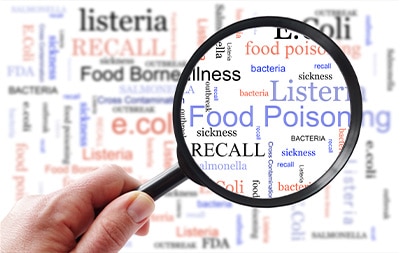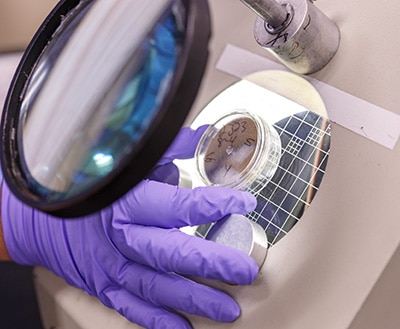Poor cleaning and sanitizing in food manufacturing can be a cause of foodborne illness by unintentionally inoculating the food products as they are manufactured.

What are we monitoring for?
An effective Environmental Monitoring Program in a food manufacturing facility determines whether a pathogen or a spoilage organism is remaining after cleaning is performed and during the manufacturing process. Environmental monitoring can determine if a facility is being cleaned and sanitized effectively.

In 2014 the FDA developed an approach to further protect the food supply by sampling not only products but collecting environmental swab samples from manufacturing facilities. Any swabs collected that test positive for microorganisms are speciated to determine if the microorganism is a pathogen. Furthermore, a Whole Genome Sequencing (WGS) is performed on the sample which can then be used to find sources of resident strains and strains of pathogen that have caused foodborne illness outbreaks. Residential strains of pathogens can become proliferate in an environment if cleaning is ineffective.
What is a resident strain microbe?
A resident strain microbe is a genetically identical microorganism species that has set up a permanent residence in a manufacturing facility. Resident strains of pathogenic or spoilage organisms are identified with WGS and can be linked from a manufacturing facility to a foodborne illness outbreak. Resident strain microbes are an indicator that the cleaning and sanitizing of certain areas in a facility are ineffective. Most often, a resident strain population will be found in a singular location in a facility, such as a drain or other area that is hard to clean. Unfortunately, these microbes can be transferred to other areas in the facility causing further contamination risk to the environment and manufactured products.

How does the environmental monitoring effect final product?
In the previous Research and Development Blog, Becky Douglas describes the journey Tree Top is working on to revalidate the manufacturing processes for microbial reduction in the finished products. A few organisms that are of specific concern in our processes are Listeria monocytogenes, Escherichia coli, and Salmonella. These microbes cause foodborne illness and can be found in and on the raw agriculture ingredients we process. Reducing or eliminating the microbes in the finished product is key to producing safe food products, but as these raw inputs are processed in the facility, there is a chance the microorganism could be transferred to the processing equipment or the environment in the facility. These contaminates in the environment are controlled with an effective sanitation and cleaning program, the environmental monitoring program verifies the effectiveness of the sanitation and cleaning program.
How to create an effective Environmental Monitoring Program
An effective Environmental Monitoring Program is created and implemented by examining areas in the manufacturing line and facility that could be a risk to residential microbes as well as areas that could cause possible product contamination. Identifying critical environmental monitoring areas from the highest risk, Zone 1, to the lowest food safety risk, Zone 4, allows for a risk-based monitoring program to be developed. One place that is often overlooked is UP. Many times, the focus of environmental monitoring is the floor, the equipment, or the surfaces around manufacturing equipment, but fail to observe areas above.
The appropriate indicator organism is also imperative to ensuring the areas are clean and sanitized to manufacture safe, quality foods. Focus on testing for the indicator organism that is most likely to be a concern in the area and in the foods being produced. An indicator organism must be a valid repetitive of the pathogenic or spoilage organism, including having the same metabolic needs to survive. This allows for an accurate representation of the organisms that could be growing in the area being tested.

When you find an area that tests positive for the indicator organism, cleaning and sanitizing must be reevaluated to ensure it’s effective in the area. Also, additional “vector” testing must occur to ensure the organism is isolated to the specific area and to identify any other areas that the organism could be located.
Summary
An Environmental Monitoring Program is an essential part of a Cleaning and Sanitation Program. The two go hand in hand. The Cleaning and Sanitation Program is verified effective by a proficient Environmental Monitoring Program. Ensuring that the Cleaning and Sanitization Program is effective assures that microorganisms that can cause foodborne illness in the final product are eliminated as a risk.
If you are looking for a reliable, quality first, fruit ingredient manufacturer, please explore our fruit product offerings or email us here.




